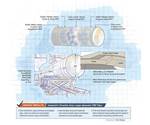Continuous filament winding: A short history
The process continues to make composite pipe production increasingly competitive with steel and concrete
The continuous filament winding process was developed in the 1970s through joint efforts by Danish inventor Frede Hilmar Drostholm, who invented an advancing mandrel machine, and Agnar Gilbu of Sandefjord, Norway, who envisioned the continuous filament winding process for fiberglass pipes and tanks. The production method was adopted by Vera Fabrikker (at that time a subsidiary of Sandefjord-based global paint supplier Jotun) in 1965, but, initially, the process was used only to make tanks. In 1968, Vera Fabrikker supplied the first pipes to customers. Veroc Technology AS was established in 1977 as a joint venture between Vera Fabrikker and Owens Corning (Toledo, OH, US). Veroc customer Amiantit (Dammam, Saudi Arabia) reportedly acquired the technology from Owens Corning in 2000, which had by then acquired a new name: Flowtite Pipe and Tank AS. More historical details are available here.
The ingenious process involves a cantilevered, horizontal rotating mandrel system. Customizable to a range of pipe diameters, the mandrel is made up of longitudinal beams fitted with small outward-facing roller bearings, a series of discs (sized to the pipe to be produced) that support the beams and a steel “band,” or endless loop. As the mandrel rotates, the steel band, which is about 2 inches/51 mm wide, is wound over the beams by a placement head on the mandrel’s supported end. As it is wound, the band also is pulled and, therefore, moves over the roller bearings in the axial direction, advancing toward the other (open) end of the mandrel. At that end, an exit head directs the band back through the mandrel’s core to the supported end, where the placement head directs it onto the mandrel again. In this way, the wound band forms a continuously advancing, smooth tool surface onto which the pipe materials are applied, via filament winding heads on either side. The wound pipe is pulled along by the advancing band through a heated zone near the mandrel’s open end to cure. Then the cured pipe exits the mandrel system, and the continuous pipe is cut to the desired length. The technology can currently fabricate pipe up to 4m/13 ft in diameter. To see the continuous filament winder process at Amiantit in Germany, see this YouTube video here.
This short aritcle is a Side Story to a CW feature story titled "Engineered large-diameter underground pipe." To read the feature article, click on its title under "Editor's Picks" at top right.
Related Content
-
Plant tour: Joby Aviation, Marina, Calif., U.S.
As the advanced air mobility market begins to take shape, market leader Joby Aviation works to industrialize composites manufacturing for its first-generation, composites-intensive, all-electric air taxi.
-
Plant tour: Albany Engineered Composites, Rochester, N.H., U.S.
Efficient, high-quality, well-controlled composites manufacturing at volume is the mantra for this 3D weaving specialist.
-
The state of recycled carbon fiber
As the need for carbon fiber rises, can recycling fill the gap?






.jpg;maxWidth=300;quality=90)






